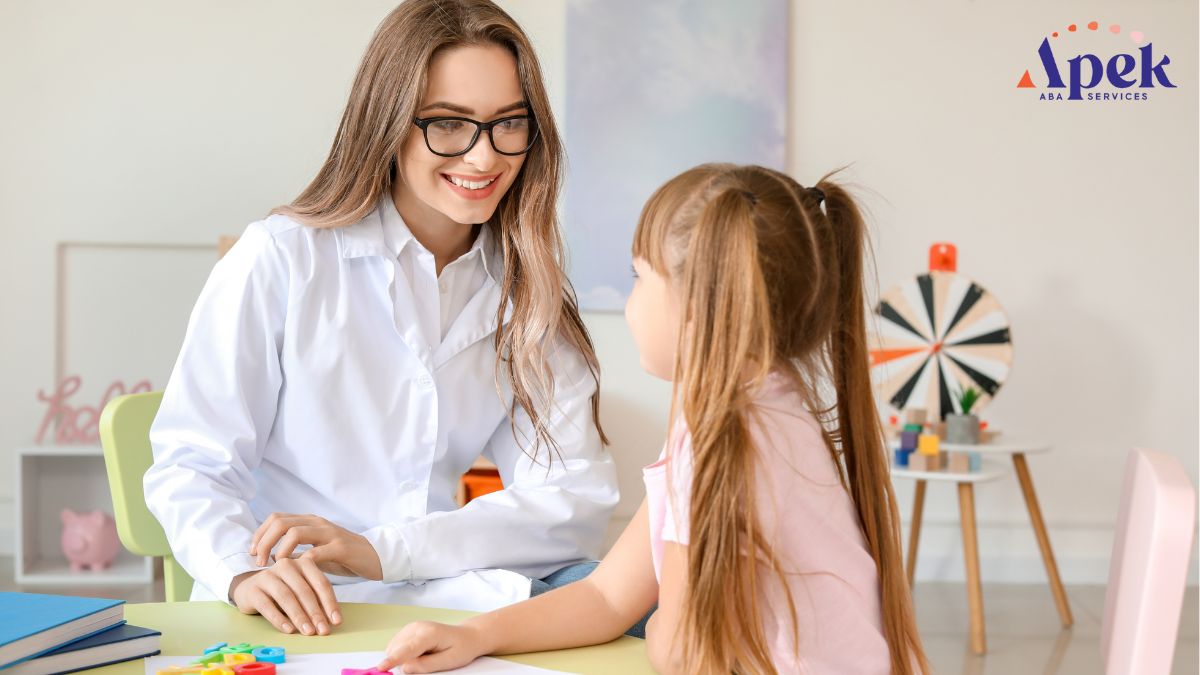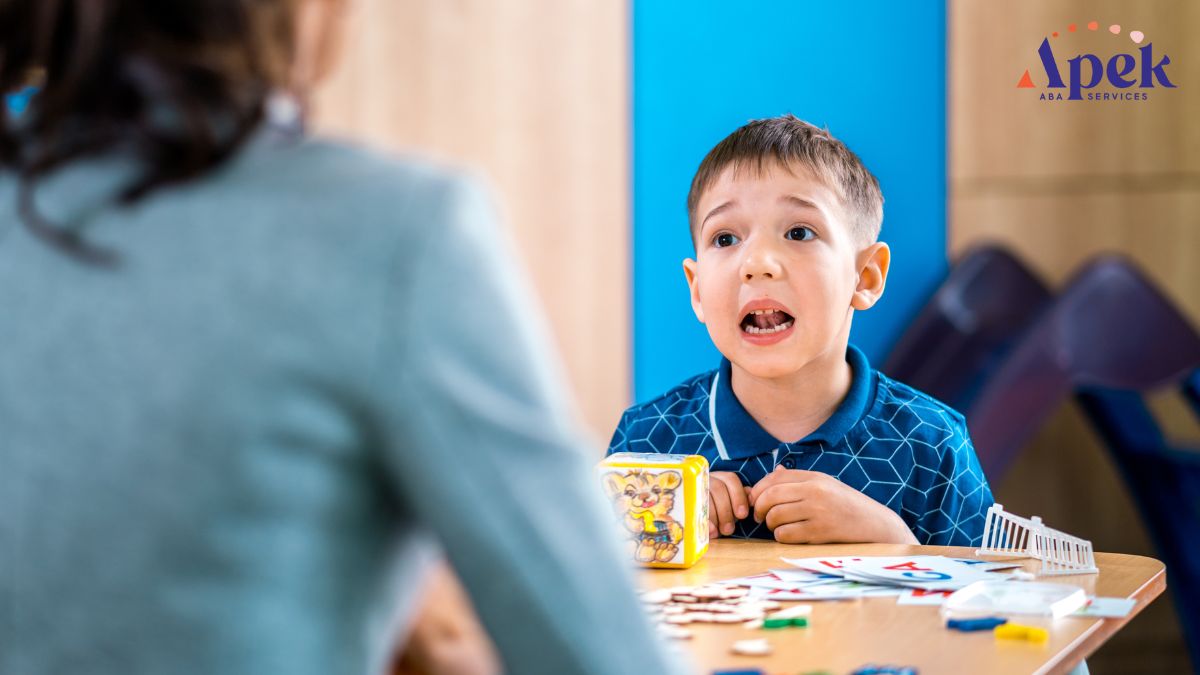Key Points:
- ABA therapy for communication in children improves speech and connection by teaching clear requests, comments, and turn-taking within daily routines.
- Functional Communication Training replaces behavior with words, Verbal Behavior Therapy and NDBI grow language during play, and AAC or PECS gives an immediate voice.
- Parent coaching multiplies practice and cuts frustration.
Communication is one of the biggest challenges many children with autism face. Parents often worry about speech delays, limited vocabulary, or struggles with social interaction. Applied behavior analysis, or ABA therapy, offers proven methods to improve communication by teaching children step by step how to use language, gestures, and social cues.
Instead of waiting for skills to appear, ABA communication uses structured techniques to help children express their needs and connect with others. Wanna know more? Read on.

Why Communication Leads Change in ABA
Parents often start ABA communication-focused therapy after months of guessing what a child wants or needs. Behavior then becomes the language. Tantrums, bolting, or rigidity can stand in for a simple “help” or “break.”
Communication instruction changes this pattern. ABA therapy for communication identifies what the child is trying to say and teaches a faster, more reliable replacement, like a sign, a picture, or a short phrase. Communication gains also improve daily routines, peer play, and learning.
To date, autism currently affects about 1 in 31 eight-year-old children in the U.S., which means more classrooms and clinics serve children with diverse language profiles.
What families usually notice first:
- Clearer requests replace problem behavior during meals, play, and transitions.
- Short exchanges grow into turn-taking, commenting, and simple conversations.
- Frustration drops as the child learns that words, pictures, or devices work faster than behaviors that used to “speak” for them.
What makes change stick day to day:
- Skills are taught where the child lives and learns so they work outside therapy.
- Goals target needs the child has often, like asking for help or saying “all done.”
- Practice happens many times a day with quick wins and quick praise.
ABA Foundations Applied to Communication
Applied behavior analysis breaks communication into teachable parts. We identify the function of a behavior, teach an easier form that serves the same function, and shape the response until it looks and sounds more like speech or AAC sentences.
Core elements used in ABA communication:
- Functional assessment: Teams learn why behavior happens and match it to a communication need such as access, escape, or attention.
- Shaping and prompting: Therapists model a small step, prompt when needed, and fade help so independence grows.
- Reinforcement that teaches: Children see that asking works. Access to what they asked for becomes the “teacher.”
How sessions translate into daily life
- Targets align with routines like snack, bath time, or cleanup, which gives built-in practice.
- Words, signs, pictures, or device buttons are within reach in every setting.
- Data guides when to raise expectations, add words, or move from single requests to short phrases.
Assessment to Action: Building a Communication Plan
A strong plan starts with what the child can do now and where breakdowns occur. The team gathers language samples, caregiver input, and motivation profiles. We look at speech sounds, receptive understanding, play skills, and sensory needs. The plan then selects the first skills that will change the day for the child and family.
Steps teams take before teaching starts
- Profile motivation: Identify items, people, and activities that the child will work for, since these drive early requesting.
- Map current skills: Note sounds, words, gestures, or AAC attempts already used so we build on what is there.
- Choose the first functions: Prioritize “request,” “reject,” and “get help” to reduce daily stress quickly.
How goals are written so progress is visible
- Goals include clear mastery criteria, like percent-correct across days, and include generalization probes in new places with new people.
- Plans mark the prompt level expected at each step so adults know when to fade help.
- Targets move from single words or icons to short combinations, then to comments and questions.
Evidence-Based Strategies That Grow Language
ABA therapy for communication blends methods. Verbal behavior therapy builds requesting, labeling, and answering questions using motivation as the engine. A 2022 meta-analysis found parent-implemented interventions produced a moderate effect size (g ≈ 0.60) on child social skills, which often include social communication outcomes.
Moreover, a 2024 study of an inclusive NDBI program reported that 49% of enrolled children had fewer than 20 functional spoken words at intake, underscoring the value of early, targeted language teaching.
How each strategy supports autism communication skills
- Verbal behavior therapy: Teaches mands, tacts, echoics, and intraverbals with dense practice and fast access to what the child wants.
- Naturalistic teaching: Embeds communication into play, routines, and peer time so language grows during fun, not only at a table.
- Functional Communication Training: Replaces behavior with a simple ask like “break,” “help,” or a picture touch that gets the same result.
- AAC and PECS: Gives an immediate voice through pictures or devices while speech continues to be encouraged and shaped.
Signs a program is on the right track
- Targets show a mix of requesting, commenting, and joint attention, not just one function.
- Sessions include varied partners and places so the child can use language everywhere.
- Data shows rising independence with prompts fading over time.
Parent Coaching That Multiplies Practice
Children spend most of their time with family, so parent coaching turns a few clinic hours into hundreds of learning moments each week. Coaching focuses on short routines that repeat daily. Parents learn to set up choices, pause at the right time, and reward any attempt that moves the child toward the goal.
What coaching looks like in simple steps
- Plan a routine: Pick snack, bath, or play. Prepare two or three chances to ask within each routine.
- Model and wait: Show the word, sign, picture, or button. Pause three to five seconds. Accept approximations.
- Reward and repeat: Deliver what was asked for right away. Repeat the routine to build fluency.
How coaching supports carryover
- Parents learn to spot motivation and turn it into a teachable request every time it appears.
- Caregivers and therapists use the same prompts and the same praise so the child gets one clear message.
- Home practice logs and short videos help coaches give precise feedback.
Verbal Behavior Therapy: From Requests to Conversation
Verbal behavior therapy (VBT) starts with motivation. If a child wants bubbles, we teach the most efficient way to ask for bubbles. We then rotate between requesting and labeling so words do not stay tied to one situation. Over time, VBT adds intraverbals like answering who, what, and where, which moves language toward conversation.
Key moves inside effective VBT sessions
- High-value items in view: Materials are present to spark natural manding opportunities.
- Short trials and fast pace: Dozens of chances per session keep engagement high and practice dense.
- Errorless teaching early: Prompts prevent failure, then fade to shape independent speech.
How teams know when to level up
- Requests expand from single words to two- and three-word phrases that fit the child’s sound system.
- Labels grow from nouns to actions, locations, and descriptors used in play.
- Answers shift from one-word responses to short phrases and then to chained responses.
AAC and PECS: A Voice While Speech Emerges
AAC gives many children a usable voice long before speech is reliable. Picture Exchange Communication System and speech-generating devices reduce the effort needed to make a clear request, and they can grow into full sentence construction.
Families sometimes worry that AAC will replace speech. Research shows that AAC often supports spoken language by giving the child practice with symbolic communication, turn taking, and reciprocity.
How teams decide whether to add AAC
- The child uses few or no words across settings or relies on behavior to get needs met.
- Attempts with signs or sounds are not yet understood by most partners.
- The child shows strong visual learning or enjoys tapping icons and sorting pictures.
How AAC grows with the child
- Core icons for “more,” “help,” “go,” and “stop” start early, then expand to verbs and descriptors.
- Sentence frames such as “I want ___ please” help children combine icons into clear messages.
- Devices and books travel to school, therapy, and community so voice is always available.
Functional Communication Training: Replace Behavior With Words
Functional Communication Training starts when behavior communicates a need. We identify the trigger and teach a request that gets the same outcome. If the child escapes a task by crying, we teach “break please.” If the child gains a toy by grabbing, we teach “my turn” or “help please.” Success depends on making the new response easier and more reliable than the old behavior.
FCT steps that drive fast wins
- Analyze function: Observe what happens before and after the behavior to learn what it “says.”
- Teach the replacement: Model a word, sign, or icon that works every time the child uses it.
- Thin and blend: Gradually add waiting, choices, or small amounts of work so skills generalize.
How FCT fits with broader communication goals
- Requests taught in FCT become starting points for VBT and NDBI expansion.
- Teams add commenting and joint attention so language moves beyond requesting.
- Plans include peers and siblings to grow natural conversation partners.

Naturalistic Teaching That Generalizes Speech
Naturalistic Developmental Behavioral Interventions combine ABA with developmental cues. Sessions follow the child’s lead and teach during play. This keeps motivation high and shows children that communication gets social rewards, not just items. The approach targets shared attention, imitation, and play skills that support later grammar and conversation.
Naturalistic moves that help language “show up” everywhere
- Follow the lead: Join the child’s activity, name actions, and create fun reasons to communicate.
- Use balanced turns: Offer short prompts, then wait so the child has time to respond.
- Embed peers: Practice sharing, commenting, and simple questions during group play.
When to shift targets
- Early sessions focus on getting needs met quickly to cut frustration.
- As requests stabilize, goals add comments, greetings, and play talk.
- Later phases add questions and storytelling tied to school and community life.
Frequently Asked Questions
Does ABA help with communication skills?
ABA helps communication by teaching functional alternatives, boosting language, and generalizing skills. Early Start Denver Model trials improved toddler language and cognition. Functional Communication Training replaces problem behavior with requests, while caregiver coaching extends joint attention, turn-taking, and requesting across home and school.
What is an example of ABA in the classroom?
An example of ABA in the classroom is Discrete Trial Teaching, where skills are taught in small steps: teacher cue, student response, consequence, and data recording. Teachers chain steps for academics or routines, fade prompts, reinforce independence, embed Functional Communication Training, and use graphs to track fluency.
Why is it hard for autistic kids to communicate?
Autistic kids find communication hard because brain development differences affect social reciprocity, nonverbal cue use, and language flexibility. Literal interpretation, attention differences, and unique learning profiles slow conversation growth. Without targeted supports, these traits limit skills across home, school, and community settings.
Get Started With Better Conversations
Families ready to grow communication can start now with ABA therapy services in Georgia and Virginia. At Apek ABA, the first goal centers on everyday talking, from clear requests to comments and simple conversations. Parent coaching sets expectations, shows what practice looks like, and tracks progress in weekly steps.
Many families report calmer routines within weeks as children learn fast ways to ask for what they need. If you are ready to build a plan that targets communication and shows progress you can see at home and school, reach out to book a consult and set your first goals today.

